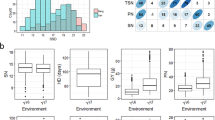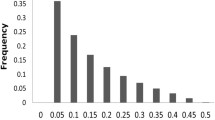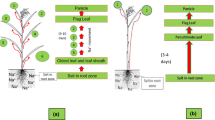Abstract
Rice is the most salt-sensitive cereal, suffering yield losses above 50% with soil salinity of 6 dS/m. Thus, understanding the mechanisms of rice salinity tolerance is key to address food security. In this chapter, we provide guidelines to assess rice salinity tolerance using a high-throughput phenotyping platform (HTP) with digital imaging at seedling/early tillering stage and suggest improved analysis methods using stress indices. The protocols described here also include computer scripts for users to improve their experimental design, run genome-wide association studies (GWAS), perform multi-testing corrections, and obtain the Manhattan plots, enabling the identification of loci associated with salinity tolerance. Notably, the computer scripts provided here can be used for any stress or GWAS experiment and independently of HTP.
Access this chapter
Tax calculation will be finalised at checkout
Purchases are for personal use only
Similar content being viewed by others
References
Roy SJ, Negrão S, Tester M (2014) Salt resistant crop plants. Curr Opin Biotechnol 26:115–124
Munns R, Tester M (2008) Mechanisms of salinity tolerance. Ann Rev Plant Biol 59:651–681
Negrão S, Schmockel SM, Tester M (2017) Evaluating physiological responses of plants to salinity stress. Ann Bot 119(1):1–11
Lutts S, Kinet JM, Bouharmont J (1995) Changes in plant response to NaCl during development of rice (Oryza sativa L) varieties differing in salinity resistance. J Exp Bot 46(293):1843–1852
Yeo AR, Yeo ME, Flowers SA, Flowers TJ (1990) Screening of rice (Oryza-Sativa-L) genotypes for physiological characters contributing to salinity resistance, and their relationship to overall performance. Theor Appl Genet 79(3):377–384
Batayeva D, Labaco B, Ye C, Li X, Usenbekov B, Rysbekova A, Dyuskalieva G, Vergara G, Reinke R, Leung H (2018) Genome-wide association study of seedling stage salinity tolerance in temperate japonica rice germplasm. BMC Genet 19(1):e2
Frouin J, Languillaume A, Mas J, Mieulet D, Boisnard A, Labeyrie A, Bettembourg M, Bureau C, Lorenzini E, Portefaix M, Turquay P, Vernet A, Périn C, Ahmadi N, Courtois B (2018) Tolerance to mild salinity stress in japonica rice: a genome-wide association mapping study highlights calcium signaling and metabolism genes. PLoS One 13(1):e0190964
Kumar V, Singh A, Mithra SV, Krishnamurthy SL, Parida SK, Jain S, Tiwari KK, Kumar P, Rao AR, Sharma SK, Khurana JP, Singh NK, Mohapatra T (2015) Genome-wide association mapping of salinity tolerance in rice (Oryza sativa). DNA Res 22(2):133–145
Ahmadizadeh M, Vispo NA, Calapit-Palao CDO, Pangaan ID, Viña CD, Singh RK (2016) Reproductive stage salinity tolerance in rice: a complex trait to phenotype. Indian J Plant Physiol 21(4):528–536
Hossain H, Rahman M, Alam M, Singh R (2015) Mapping of quantitative trait loci associated with reproductive-stage salt tolerance in rice. J Agron Crop Sci 201(1):17–31
Gregorio GB, Senadhira D, Mendoza RD (1997) Screening rice for salinity tolerance, IRRI discussion paper series
Ismail AM, Horie T (2017) Genomics, physiology, and molecular breeding approaches for improving salt tolerance. Annu Rev Plant Biol 68:405–434
Fahlgren N, Gehan MA, Baxter I (2015) Lights, camera, action: high-throughput plant phenotyping is ready for a close-up. Curr Opin Plant Biol 24:93–99
Junker A, Muraya MM, Weigelt-Fischer K, Arana-Ceballos F, Klukas C, Melchinger AE, Meyer RC, Riewe D, Altmann T (2015) Optimizing experimental procedures for quantitative evaluation of crop plant performance in high throughput phenotyping systems. Front Plant Sci 5:e770
Berger B, de Regt B, Tester M (2012) Trait dissection of salinity tolerance with plant phenomics. In: Shabala S, Cuin TA (eds) Plant salt tolerance: methods and protocols. Humana Press, Totowa, NJ, pp 399–413
Rajendran K, Tester M, Roy SJ (2009) Quantifying the three main components of salinity tolerance in cereals. Plant Cell Environ 32(3):237–249
Al-Tamimi N, Brien C, Oakey H, Berger B, Saade S, Ho YS, Schmockel SM, Tester M, Negrão S (2016) Salinity tolerance loci revealed in rice using high-throughput non-invasive phenotyping. Nat Commun 7:13342
Campbell MT, Knecht AC, Berger B, Brien CJ, Wang D, Walia H (2015) Integrating image-based phenomics and association analysis to dissect the genetic architecture of temporal salinity responses in rice. Plant Physiol 168(4):1476–1489
Zhao K, Tung C-W, Eizenga GC, Wright MH, Ali ML, Price AH, Norton GJ, Islam MR, Reynolds A, Mezey J, McClung AM, Bustamante CD, McCouch SR (2011) Genome-wide association mapping reveals a rich genetic architecture of complex traits in Oryza sativa. Nat Commun 2:e467
Li X, Guo Z, Lv Y, Cen X, Ding X, Wu H, Li X, Huang J, Xiong L (2017) Genetic control of the root system in rice under normal and drought stress conditions by genome-wide association study. PLoS Genet 13(7):e1006889
Crowell S, Korniliev P, Falcao A, Ismail A, Gregorio G, Mezey J, McCouch S (2016) Genome-wide association and high-resolution phenotyping link Oryza sativa panicle traits to numerous trait-specific QTL clusters. Nat Commun 7:10527
McCouch SR, Wright MH, Tung C-W, Maron LG, McNally KL, Fitzgerald M, Singh N, DeClerck G, Agosto-Perez F, Korniliev P, Greenberg AJ, Naredo MEB, Mercado SMQ, Harrington SE, Shi Y, Branchini DA, Kuser-Falcão PR, Leung H, Ebana K, Yano M, Eizenga G, McClung A, Mezey J (2016) Open access resources for genome-wide association mapping in rice. Nat Commun 7:e10532
3 R G P (2014) The 3,000 rice genomes project. GigaScience 3(1)
Wang DR, Agosto-Pérez FJ, Chebotarov D, Shi Y, Marchini J, Fitzgerald M, McNally KL, Alexandrov N, McCouch SR (2018) An imputation platform to enhance integration of rice genetic resources. Nat Commun 9(1):3519
Wang W, Mauleon R, Hu Z, Chebotarov D, Tai S, Wu Z, Li M, Zheng T, Fuentes RR, Zhang F (2018) Genomic variation in 3,010 diverse accessions of Asian cultivated rice. Nature 557(7703):e43
Li Y, Xiao JH, Chen LL, Huang XH, Cheng ZK, Han B, Zhang QF, Wu CY (2018) Rice functional genomics research: past decade and future. Mol Plant 11(3):359–380
Gioia T, Galinski A, Lenz H, Muller C, Lentz J, Heinz K, Briese C, Putz A, Fiorani F, Watt M, Schurr U, Nagel KA (2017) GrowScreen-PaGe, a non-invasive, high-throughput phenotyping system based on germination paper to quantify crop phenotypic diversity and plasticity of root traits under varying nutrient supply. Funct Plant Biol 44(1):76–93
Parent B, Conejero G, Tardieu F (2009) Spatial and temporal analysis of non-steady elongation of rice leaves. Plant Cell Environ 32(11):1561–1572
Gilmour AR, Cullis BR, Verbyla AP (1997) Accounting for natural and extraneous variation in the analysis of field experiments. J Agric Biol Environ Stat 2(3):269–293
Brien CJ, Berger B, Rabie H, Tester M (2013) Accounting for variation in designing greenhouse experiments with special reference to greenhouses containing plants on conveyor systems. Plant Methods 9(1):5
Cullis BR, Smith AB, Coombes NE (2006) On the design of early generation variety trials with correlated data. J Agric Biol Environ Stat 11(4):381
Coombes N (2009) DiGGer, a spatial design program. Biometric Bulletin. NSW Department of Primary Industries, Orange, NSW
Morton MJL, Awlia M, Al-Tamimi N, Saade S, Pailles Y, Negrão S, Tester M (2019) Salt stress under the scalpel—dissecting the genetics of salt tolerance. Plant J
Hairmansis A, Berger B, Tester M, Roy SJ (2014) Image-based phenotyping for non-destructive screening of different salinity tolerance traits in rice. Rice 7(1):16
Yichie Y, Brien C, Berger B, Roberts TH, Atwell BJ (2018) Salinity tolerance in Australian wild Oryza species varies widely and matches that observed in O. sativa. Rice 11(1):66
Berry JC, Fahlgren N, Pokorny AA, Bart RS, Veley KM (2018) An automated, high-throughput method for standardizing image color profiles to improve image-based plant phenotyping. PeerJ 6:e5727
Czedik-Eysenberg A, Seitner S, Güldener U, Koemeda S, Jez J, Colombini M, Djamei A (2018) The ‘PhenoBox’, a flexible, automated, open-source plant phenotyping solution. New Phytologist.
Klukas C, Chen D, Pape J-M (2014) IAP: an open-source information system for high-throughput plant phenotyping. Plant Physiol 113:233932
Hunt R, Causton DR, Shipley B, Askew AP (2002) A modern tool for classical plant growth analysis. Ann Bot 90(4):485–488
Furbank RT, Tester M (2011) Phenomics—technologies to relieve the phenotyping bottleneck. Trends Plant Sci 16(12):635–644
Brien C (2016) asremlPlus: Augments the use of ‘ASReml-R’in fitting mixed models. R package version 2.0-12
Brien C (2016) imageData: an R package that aids in processing and plotting data from a Lemna-Tec Scanalyzer, R foundation for statistical computing
Rousseeuw PJ, Hubert M (2011) Robust statistics for outlier detection. Wiley Interdiscip Rev Data Mining Knowl Discov 1(1):73–79
Rosielle A, Hamblin J (1981) Theoretical aspects of selection for yield in stress and non-stress environments. Crop Sci 21(6):943–946
Munns R (2002) Comparative physiology of salt and water stress. Plant Cell Environ 25(2):239–250
Saade S, Maurer A, Shahid M, Oakey H, Schmockel SM, Negrão S, Pillen K, Tester M (2016) Yield-related salinity tolerance traits identified in a nested association mapping (NAM) population of wild barley. Sci Rep 6:32586
Fischer R, Maurer R (1978) Drought resistance in spring wheat cultivars. I. Grain yield responses. Aust J Agric Res 29(5):897–912
Fernandez GC (1992) Effective selection criteria for assessing plant stress tolerance. International symposium on adaptation of vegetables and other food crops in temperature and water stress. AVRDC, Tainan
Rameeh V, Rezai A, Saeidi G (2004) Study of salinity tolerance in rapeseed. Commun Soil Sci Plant Anal 35(19–20):2849–2866
Goudarzi M, Pakniyat H (2008) Evaluation of wheat cultivars under salinity stress based on some agronomic and physiological traits. J Agricult Social Sci 4:35–38
Krishnamurthy S, Gautam R, Sharma P, Sharma D (2016) Effect of different salt stresses on agro-morphological traits and utilisation of salt stress indices for reproductive stage salt tolerance in rice. Field Crop Res 190:26–33
Falconer DS, Mackay TF (1996) Introduction to quantitative genetics. Longman, Burnt Mill
Isik F, Holland J, Maltecca C (2017) Spatial analysis. Genetic data analysis for plant and animal breeding. Springer, Cham, pp 203–226
Nyquist WE (1991) Estimation of heritability and prediction of selection response in plant-populations. Crit Rev Plant Sci 10(3):235–322
Holland JB, Nyquist WE, Cervantes-Martínez CT (2003) Estimating and interpreting heritability for plant breeding: an update. Plant breeding reviews
Butler D, Cullis BR, Gilmour A, Gogel B (2009) ASReml-R reference manual. The State of Queensland, Department of Primary Industries and Fisheries, Brisbane
Huang X, Han B (2014) Natural variations and genome-wide association studies in crop plants. Annu Rev Plant Biol 65:531–551
Begum H, Spindel JE, Lalusin A, Borromeo T, Gregorio G, Hernandez J, Virk P, Collard B, McCouch SR (2015) Genome-wide association mapping for yield and other agronomic traits in an elite breeding population of tropical rice (Oryza sativa). PLoS One 10(3):e0119873
Yang W, Guo Z, Huang C, Duan L, Chen G, Jiang N, Fang W, Feng H, Xie W, Lian X (2014) Combining high-throughput phenotyping and genome-wide association studies to reveal natural genetic variation in rice. Nat Commun 5:5087
Yano K, Yamamoto E, Aya K, Takeuchi H, Lo P-c, Hu L, Yamasaki M, Yoshida S, Kitano H, Hirano K (2016) Genome-wide association study using whole-genome sequencing rapidly identifies new genes influencing agronomic traits in rice. Nat Genet 48(8):927
Raboin L-M, Ballini E, Tharreau D, Ramanantsoanirina A, Frouin J, Courtois B, Ahmadi N (2016) Association mapping of resistance to rice blast in upland field conditions. Rice 9(1):59
Volante A, Tondelli A, Aragona M, Valente MT, Biselli C, Desiderio F, Bagnaresi P, Matic S, Gullino ML, Infantino A, Spadaro D, Valè G (2017) Identification of bakanae disease resistance loci in japonica rice through genome wide association study. Rice 10(1):29
Famoso AN, Zhao K, Clark RT, Tung C-W, Wright MH, Bustamante C, Kochian LV, McCouch SR (2011) Genetic architecture of aluminum tolerance in rice (Oryza sativa) determined through genome-wide association analysis and QTL mapping. PLoS Genet 7(8):e1002221
Wang D, Liu J, Li C, Kang H, Wang Y, Tan X, Liu M, Deng Y, Wang Z, Liu Y (2016) Genome-wide association mapping of cold tolerance genes at the seedling stage in rice. Rice 9(1):61
Zhang Z, Ersoz E, Lai C-Q, Todhunter RJ, Tiwari HK, Gore MA, Bradbury PJ, Yu J, Arnett DK, Ordovas JM (2010) Mixed linear model approach adapted for genome-wide association studies. Nat Genet 42(4):355
Bradbury PJ, Zhang Z, Kroon DE, Casstevens TM, Ramdoss Y, Buckler ES (2007) TASSEL: software for association mapping of complex traits in diverse samples. Bioinformatics 23(19):2633–2635
Lipka AE, Tian F, Wang Q, Peiffer J, Li M, Bradbury PJ, Gore MA, Buckler ES, Zhang Z (2012) GAPIT: genome association and prediction integrated tool. Bioinformatics 28(18):2397–2399
Tang Y, Liu X, Wang J, Li M, Wang Q, Tian F, Su Z, Pan Y, Liu D, Lipka AE, Buckler ES, Zhang Z (2016) GAPIT version 2: an enhanced integrated tool for genomic association and prediction. Plant Genome 9(2)
Turner SD (2014) qqman: an R package for visualizing GWAS results using QQ and manhattan plots. BioRxiv: 005165
Dabney A, Storey JD, Warnes G (2010) qvalue: Q-value estimation for false discovery rate control. R package version 1(0)
Yu J, Pressoir G, Briggs WH, Vroh Bi I, Yamasaki M, Doebley JF, McMullen MD, Gaut BS, Nielsen DM, Holland JB, Kresovich S, Buckler ES (2006) A unified mixed-model method for association mapping that accounts for multiple levels of relatedness. Nat Genet 38(2):203–208
Crainiceanu CM, Ruppert D (2004) Likelihood ratio tests in linear mixed models with one variance component. J Royal Stat Soc B Stat Methodol 66:165–185
Korte A, Farlow A (2013) The advantages and limitations of trait analysis with GWAS: a review. Plant Methods 9(1):29
Piepho H-P, Möhring J (2007) Computing heritability and selection response from unbalanced plant breeding trials. Genetics 177(3):1881–1888
Self SG, Liang KY (1987) Asymptotic properties of maximum-likelihood estimators and likelihood ratio tests under nonstandard conditions. J Am Stat Assoc 82(398):605–610
Stram DO, Lee JW (1994) Variance-components testing in the longitudinal mixed effects model. Biometrics 50(4):1171–1177
R: A language and environment for statistical computing (R Foundation for Statistical Computing, Vienna, Austria, 2015).
Acknowledgments
Financial support from King Abdullah University of Science and Technology (KAUST) is gratefully acknowledged. Sónia Negrão thanks the financial support of University College Dublin (UCD) and UCD School of Biology and Environmental Science.
Author information
Authors and Affiliations
Corresponding author
Editor information
Editors and Affiliations
Rights and permissions
Copyright information
© 2021 Springer Science+Business Media, LLC, part of Springer Nature
About this protocol
Cite this protocol
Al-Tamimi, N., Oakey, H., Tester, M., Negrão, S. (2021). Assessing Rice Salinity Tolerance: From Phenomics to Association Mapping. In: Bandyopadhyay, A., Thilmony, R. (eds) Rice Genome Engineering and Gene Editing. Methods in Molecular Biology, vol 2238. Humana, New York, NY. https://doi.org/10.1007/978-1-0716-1068-8_23
Download citation
DOI: https://doi.org/10.1007/978-1-0716-1068-8_23
Published:
Publisher Name: Humana, New York, NY
Print ISBN: 978-1-0716-1067-1
Online ISBN: 978-1-0716-1068-8
eBook Packages: Springer Protocols




